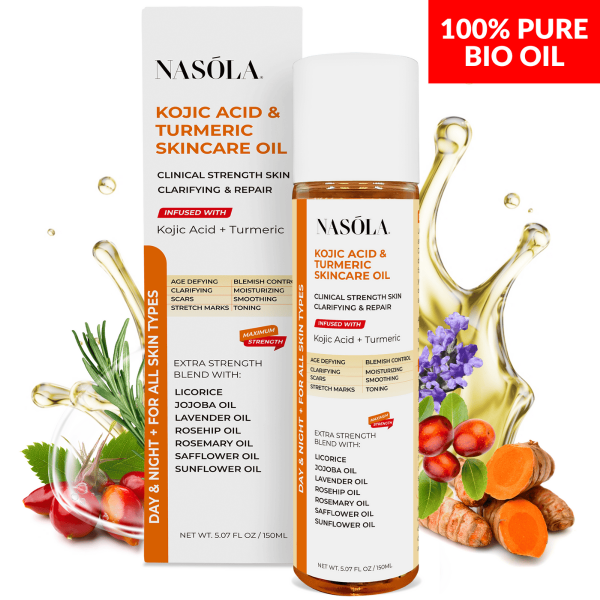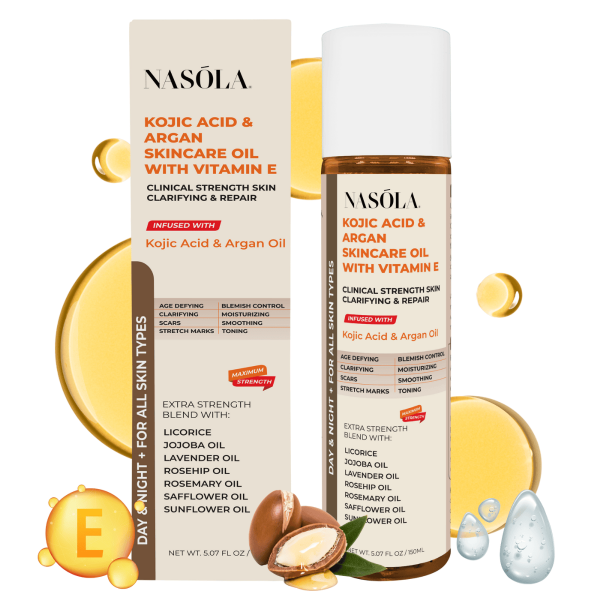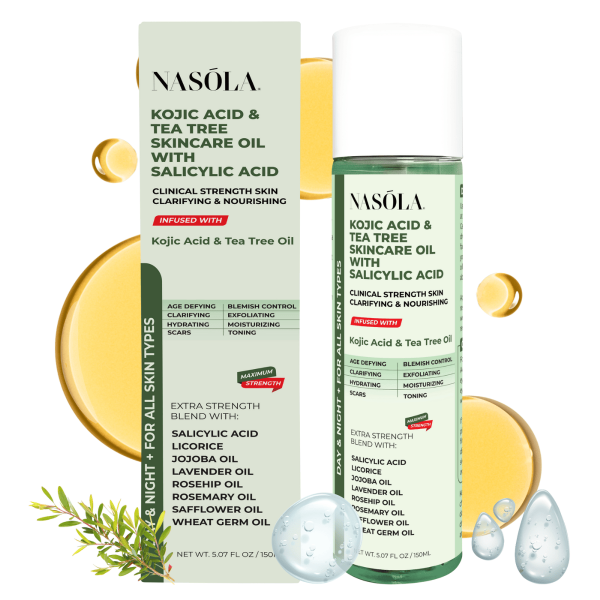Ever stood in the skincare aisle or scrolled online, wondering…does Bio Oil lighten skin? You’re definitely not alone 🤔
It’s such a common question—and a fair one—because between dark spots, uneven skin tone, old acne scars, or post-pregnancy discoloration, many of us are chasing that radiant, even-toned glow 🌟
Bio Oil has been a household name for years, but lately, new formulations infused with brightening ingredients like kojic acid, turmeric, tea tree oil, and salicylic acid are shifting the narrative.
So…can Bio Oil genuinely make your skin lighter?
Let’s not guess. We’re breaking it all down—the ingredients, the myths, the best products, and how to pick the one that actually works for YOUR skin 🧴✨
- Does Bio Oil Lighten Skin? Separating Fact from Fiction
- Ingredient Spotlight: Kojic Acid’s Role in Lightening Skin
- Turmeric and Its Skin Brightening Benefits in Bio Oil Products
- Can Tea Tree and Salicylic Acid in Bio Oil Help with Acne-Related Pigmentation?
- The Power of Argan Oil in Brightening and Rejuvenating Skin
- Which Bio Oil Is Right for You Based on Skin Concerns?
- Conclusion
- Frequently Asked Questions (FAQs)
Does Bio Oil Lighten Skin? Separating Fact from Fiction

If you’ve ever used traditional Bio Oil, you probably loved the way it nourished your skin. It’s a dreamy hydrator. But if you were expecting your hyperpigmentation to vanish overnight…mmm, let’s not lie to ourselves 😅
The core function of the original Bio Oil is skin repair—great for scars and hydration, yes—but not a major brightener. However, things change when we add ingredients like kojic acid or turmeric.
These heroes work on melanin production and inflammation, giving Bio Oil an impressive glow-up.
So let’s be clear: Original Bio Oil helps improve appearance over time, but Bio Oils with added brighteners? That’s where things get brighter—literally 😍
How Bio Oil Works on the Skin
Bio Oil in its classic form contains ingredients like PurCellin Oil, vitamin A, and vitamin E, which improve texture, tone, and discoloration. But there’s a catch.
It moisturizes, yes. Softens skin? Absolutely. But it does not directly inhibit melanin production—the root of pigmentation issues.
That’s why people with stubborn dark spots or acne scars often feel let down unless the Oil is upgraded with powerful skin tone correctors.
Bio Oil works best when its healing qualities are combined with:
- Pigment-reducing agents like Kojic Acid.
- Anti-inflammatory root boosters like Turmeric.
- Acne-clearing champions like Tea Tree and Salicylic Acid.
- Moisture barriers like Argan Oil to fuel cell renewal.
Want your Bio Oil to actually lighten discoloration (not just soften it)? THEN you need a blend like Nasola Kojic Acid + Turmeric Bio Oil—a formulation that attacks pigmentation while still loving your skin gently 💛
Role of Kojic Acid in Skin Brightening
Here’s the real glow-up: Kojic Acid. Popular in Asian and African skincare for decades—and backed by dermatologists—this powerhouse blocks tyrosinase, an enzyme responsible for melanin production.
Translation? Less melanin = lighter, more even skin tone.
Kojic Acid wears many hats:
- Fades stubborn dark spots like post-acne marks and sunspots.
- Battles melasma and pregnancy-related hyperpigmentation.
- Brightens dull patches with noticeable radiance.
- Helps soften fine lines over time.
The magic multiplies when paired with other actives. For example, Nasola Kojic Acid + Turmeric Bio Oil synergizes turmeric’s anti-inflammatory charm with kojic’s pigment-lifting action. Bright AND calm? We call that a skin miracle.
Ingredient Spotlight: Kojic Acid’s Role in Lightening Skin

If you haven’t fallen for Kojic Acid yet, get ready—it’s about to become your pigmentation-fighting BFF 🧪✨
Extracted from fermented rice or fungi, Kojic Acid is a smart, natural alternative to hydroquinone. It doesn’t bleach; it balances. That’s what makes it so skin-loving.
What is Kojic Acid?
When rice ferments during sake-making, kojic acid is born. It’s been used in Japanese skincare for years, prized for whitening effects without the harsh rebound.
In skincare:
- It gently inhibits excess melanin.
- Prevents new dark spots after sun exposure.
- Reduces visible scars and inflammation.
- Speeds up post-acne healing.
But here’s the REAL flex. When used daily, kojic acid doesn’t shock the skin. It whispers, “Hey, chill out on the pigment, please. Thanks.”
For those with acne-prone skin and dark marks, try the multitasking Nasola Kojic Acid + Tea Tree Bio Oil with Salicylic Acid.
Benefits of Kojic Acid in Skincare Products
This isn’t a trend. Kojic Acid offers real, noticeable results:
- Brightens complexions gently over time.
- Reduces the severity of melasma and discoloration.
- Lightens scars without leaving skin sensitive.
- Revives dullness—leaving you glow-powered ✨
Products like Nasola Kojic Acid + Tea Tree Bio Oil with Salicylic Acid offer acne-fighting support with added radiance. These are optimized tools for those who want clarity and brightness—in one bottle. No fluff. Just facts.
Turmeric and Its Skin Brightening Benefits in Bio Oil Products
Turmeric isn’t just for golden lattes. It’s been the crown jewel of holistic skin rituals for centuries 🌿
Whether you’re dealing with dullness or irritated skin, turmeric has your back—with powerful antioxidants and anti-inflammatory properties that bring back skin harmony.
Traditional Uses of Turmeric in Skin Care
In Ayurveda and ancient Eastern cultures:
- Brides would apply turmeric before wedding ceremonies.
- It was used to calm psoriasis, eczema, or any flare-ups.
- Grandmothers swore by it for acne, pigmentation, AND glow.
Known for:
- Neutralizing free radicals.
- Lightening sun-damaged spots.
- Enhancing overall skin tone.
- Reducing redness and inflammation.
Turmeric isn’t a fad. It’s a glow activator.
How Turmeric Enhances Skin Tone When Combined with Bio Oil
Pair turmeric with the nourishing base of Bio Oil, and…hello radiance 🙌🏾
Nasola Kojic Acid + Turmeric Bio Oil delivers a double-dose solution:
- Kojic Acid evens tone and fades discoloration.
- Turmeric calms the skin and boosts radiance.
- The oil base locks moisture and enhances absorption.
- Ideal for deeper skin tones prone to scarring.
And let’s be honest—who doesn’t love a multitasking gem?
Can Tea Tree and Salicylic Acid in Bio Oil Help with Acne-Related Pigmentation?

If your scars love to linger after breakouts, you’re probably desperate for rescue. GOOD NEWS: There is light (and clear skin) at the end of the tunnel.
Tea Tree purifies; salicylic acid exfoliates—and in a lightweight oil format, they’ll transform post-acne blues into post-acne brilliance.
Tea Tree as a Natural Solution for Blemishes
Why do we love Tea Tree Oil? Because it:
- Combats acne-causing bacteria naturally.
- Reduces inflammation and swelling.
- Prevents future breakouts while healing old ones.
- Fades red and brown post-pimple marks.
Tea Tree isn’t harsh. It’s graceful—but tough where it counts. And when blended into a brightening product like Nasola Kojic Acid + Tea Tree Bio Oil with Salicylic Acid, it becomes the ultimate triple-threat: brightener, healer, protector 💥
Salicylic Acid for Exfoliation and Skin Lightening
Salicylic Acid is the unsung hero of chemical exfoliants:
- Penetrates pores and dissolves gunk.
- Gently sloughs away dead and dull cells.
- Speeds up healing of spots and pigmentation.
- Allows other brightening agents to work better.
It’s especially powerful for oily or congested skin.
Together with Tea Tree and Kojic Acid, it’s the reason Nasola Kojic Acid + Tea Tree Bio Oil with Salicylic Acid is basically skincare alchemy.
The Power of Argan Oil in Brightening and Rejuvenating Skin
Glow doesn’t mean dry. And lightening should never mean stripping!
Enter Argan Oil: silky, luxurious, and deeply restorative…
What Makes Argan Oil Great for Skin?
Argan Oil is all about replenishment:
- Packed with vitamin E to fight free radicals.
- Filled with fatty acids that rebuild your skin’s barrier.
- Softens rough texture and fine lines.
- Moisturizes without greasiness.
When your skin is well-loved and nourished, pigmentation heals faster. It’s science AND soft care 💧
Argan Oil’s Support Role in Skin Tone Brightening
In Nasola Kojic Acid + Argan Bio Oil, Argan plays backup singer to Kojic Acid…but WHAT a performance 🧡
- Helps sensitive skin types absorb lightening agents.
- Minimizes irritation or flakiness.
- Repairs damage from sun and pollutants.
- Boosts radiance by promoting cell turnover.
Pair this with nightly use and your skin will not only look better—but feel magnificent.
Which Bio Oil Is Right for You Based on Skin Concerns?
Choices can be overwhelming. Let’s make it easy. Here’s how to choose the best Bio Oil blend for YOUR skin TLC moment:
Sensitive Skin and Hyperpigmentation
- Choose: Nasola Kojic Acid + Argan Bio Oil
- WHY: Light, soothing, and won’t irritate—a gentler way to brighten.
Post-Acne Marks and Oily Skin
- Choose: Nasola Kojic Acid + Tea Tree Bio Oil with Salicylic Acid
- WHY: Fights blemishes while softening pigmentation.
Dull, Uneven Tone
- Choose: Nasola Kojic Acid + Turmeric Bio Oil
- WHY: Boosts radiance and glow naturally.
Conclusion
So…does Bio Oil lighten skin?
The original formula? Not quite. But upgraded versions—enriched with Kojic Acid, Turmeric, Tea Tree, Salicylic Acid, and Argan Oil? Massive YES ✔️
Use them daily, trust the process, and your skin will reward you in 4–6 weeks with fewer dark spots, smoother tone, and that vibrant, photo-ready glow ✨
Your path to radiant skin can—and should—feel indulgent, gentle, and clean. Nasola’s Bio Oil collection lets you experience just that ❤️
Try the version that fits your skin best. Because everyone deserves to feel good in their skin—and look the part, too 😉
Frequently Asked Questions (FAQs)
Traditional Bio Oil supports skin healing, but it lacks active brightening agents. If you’re looking for natural lightening, opt for upgraded versions with Kojic Acid and plant-powered ingredients like turmeric, which help fade discoloration over time.
Our top pick: Nasola Kojic Acid + Turmeric Bio Oil. Kojic Acid fades pigment fast, while turmeric calms inflammation, making it amazing for visibly reducing dark patches.
Absolutely. Daily use is highly recommended! But you’ll see the best results using Bio Oils that are specifically formulated with Kojic Acid, Turmeric, or Salicylic Acid to target uneven tone.
Consistency is key. Depending on your skin concern, visible lightening can appear in 4–6 weeks. Deeper hyperpigmentation may require a few months.
Yes, but only versions with active lightening ingredients. Nasola Kojic Acid + Argan Bio Oil does wonders for melasma when used consistently.
Definitely! Nasola Bio Oils absorb easily and create a smooth, hydrated base. Perfect if you want your foundation to glide and glow.
Yes, turmeric rejuvenates tired skin with vitality and luster. It targets dullness at the root—bye-bye gray complexion, hello glow!
Nasola Kojic Acid + Tea Tree Bio Oil with Salicylic Acid is your go-to. It clears breakouts while lightening dark marks—total win.
Nasola Kojic Acid + Argan Bio Oil is ultra-soothing with vitamin E-rich Argan Oil—it strengthens the skin while fading age spots.
Side effects are rare. Some sensitive skin types may notice mild tingling—always patch test first. Stick to once-daily use and moisturize after if needed.




